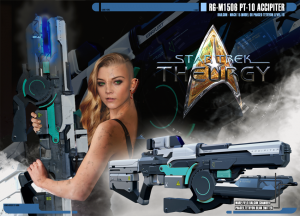The Accipiter
From Star Trek: Theurgy Wiki
The RG-M1506 PT-10 Accipiter, was a state-of-the-art heavy support rifle that hailed from early 25th century technology. It was recovered from the cockpits of destroyed Reavers after the last battle against the USS Calamity and there were 5 individuals of these weapons. They were not freely distributed to officers on the Theurgy without consent of two members of the Senior Staff.
The first Accipiter was recovered from the Reaver that Evelyn Rawley landed in the hangar after the escape from Theta Eridani IV, yet with the grip and retinal scanners, it was useless until Thea could derive the code that restored the weapons to their factory settings. Obviously, the Accipiter was meant as a heavy infantry support weapon and not pilot standard issue, but for the holograms in the Reavers, the weight of these weapons were not a disadvantage, and thus became standard gear in the cockpits.
Technical Specifications
The Accipiter featured a new hand-held RailGun system. A Rapid Loader Replicator created an 7 mm Tungsten Carbide bullet which was then loaded into the Micro Warp Field Generator. The generator created a short lasting warp field around the bullet. The bullet, now virtually weightless, was pushed through a magnetic field which pushed the bullet up to speeds of Mach 15. This entire process took less than .0006% of a second. This allowed the gun to shot a maximum of 1500 bullet per minute. Though meant to be fired in bursts, this rifle could fire for a solid 20 seconds before it would need to be reloaded. Due to this new system, the device could launch a projectile at high velocity without any muzzle flash or burst or chemical propellent.
It should be noted that due to the high rate of fire, firing for more than 15 seconds solid risked a catastrophic overheat. Due to size and weight limitations and a high rate of fire the super-cooling conductor inside the device, a cooling conduit - designed to convert residual heat into additional power for the machine - could be overloaded and cease to function. At which time the device would no longer be able to get rid of excess heat. Though the parts were rated to a high heat tolerance, the Biomemetic materials in the sight would fail at temperatures exceeding 540 K. In addition, the overheated housing could cause damage to any organic tissue in contact with the device.
Firing Modes
The device had a number of unique firing options. This included three unique settings for the railgun, an experimental railgun dry firing feature that created a burst of concussive force, and a newly designed Phased Tetryon Beam Emitter.
1. Railgun Firing Options
The first firing mode for the rail gun bullets only fired a single shot each time the trigger was pulled. This was ideal for hitting an unshielded target within a 1 km range. Next was a burst of 10 bullets per trigger pull (0,5 second burst). This option was ideal for combat in tight corridors and in situations where it was best if ammunition was reserved. In addition, the first two options allowed for a great deal of control. Finally, the third option allowed for a continual firing. This option was ideal for dealing with a large number of targets and situations where aiming at individual targets was no longer an option.
2. Warp Concussion Mode
A new experimental feature allowed for the railgun to be fired without a projectile. Instead, the device created a short lasting warp bubble and launched it at high velocity. Within three meters of the gun, the warp bubble would dissolve and create a concussive force which could be used to repel targets that were swarming the shooter, break up debris, or push objects too heavy to normally be moved. This option was still highly experimental, and though field tests had shown it to be useful, it should only be used on the single shot setting of the device.
3. Phased Tetryon Beam
Tetryon beams weaked and disabled most types of shielding while not damaging organic tissue, making this emitter the preliminary firing option before switching to the railgun once a shield had been disabled. The Phased Tetryon Beam Emitter used this technology in parallel with phaser emitter technology, a standard issue that was commonly found in the majority of Starfleet hand phasers and rifles. The combination of the two emitters allowed for a single beam that could not only weaken and disable shields but also stun a target. This allowed for a single weapon that could do the job it would normally take two unique beams weapons to do.
In addition, there were a number of stun settings that could be used, from the low stun setting which could disable most adults to maximum stun setting which is strong enough to immobilise a Soong-type android. The reason why there was no kill-settings in the emitter was that it would render the effect of the tetryon beam inadequate of breaking down shields.
4. Tetryon Sensor Marker
In addition, thanks to a unique targeting sensor in the scope, it was possible to use the tetryon emitter to mark targets, making for a near permanent weapon lock on that target as long as it was within a 20 degree angle in front of the Accipiter's muzzle. This unique feature allowed for continual target lock even when other sensors could no longer pick up the target due to obstructions. Though the range and power of the lock was highly variable, it was still useful in situations where visible contact with the target could not be maintained.

